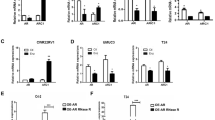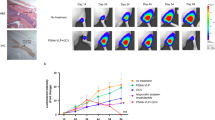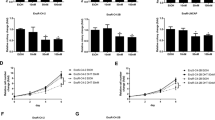Abstract
The high frequency of recurrence and poor survival rate of bladder cancer demand exploration of novel strategies. Gene therapy via adenovirus has shown promising potential for the treatment of tumors. We constructed a bladder cancer-specific adenovirus carrying E1A-androgen receptor (AR) under the control of UPII promoter and prostate stem cell antigen enhancer (PSCAE), designated as Ad/PSCAE/UPII/E1A-AR, and investigated its antitumor effects in vitro and in vivo. We demonstrated that Ad/PSCAE/UPII/E1A-AR could be selectively replicated in bladder tumor cell lines (5637, BIU87, EJ and T24) when compared with control adenovirus Ad/PSCAE/UPII/Luc. However, there was no evidence of cytotoxicity for normal human bladder cell line SV-HUC-1 and hepatoma cell line SMMC7721. AR agonist R1881 could strengthen the oncolytic effect of Ad/PSCAE/UPII/E1A-AR in bladder cancer cells. In addition, we demonstrated that intratumoral injection of Ad/PSCAE/UPII/E1A-AR into established subcutaneous human EJ tumors in nude mice could significantly regress the growth of tumor and markedly prolong survival for tumor-bearing mice; on the other hand, saline-treated tumors continued to grow rapidly. Our studies indicate that Ad/PSCAE/UPII/E1A-AR could effectively treat bladder cancer in vitro and in vivo. Furthermore, our findings provide a promising therapeutic modality for the treatment of bladder cancer.
This is a preview of subscription content, access via your institution
Access options
Subscribe to this journal
Receive 12 print issues and online access
$259.00 per year
only $21.58 per issue
Buy this article
- Purchase on Springer Link
- Instant access to full article PDF
Prices may be subject to local taxes which are calculated during checkout







Similar content being viewed by others
References
Jemal A, Siegel R, Ward E, Hao Y, Xu J, Murray T et al. Cancer statistics, 2008. CA Cancer J Clin 2008; 58: 71–96.
Voutsinas GE, Stravopodis DJ . Molecular targeting and gene delivery in bladder cancer therapy. J BUON 2009; 14 (Suppl 1): S69–S78.
Kompier LC, Lurkin I, van der Aa MN, van Rhijn BW, van der Kwast TH, Zwarthoff EC . FGFR3, HRAS, KRAS, NRAS and PIK3CA mutations in bladder cancer and their potential as biomarkers for surveillance and therapy. PLoS One 2010; 5: e13821.
Frisch SM . Tumor suppression activity of adenovirus E1a protein: anoikis and the epithelial phenotype. Adv Cancer Res 2001; 80: 39–49.
Hubberstey AV, Pavliv M, Parks RJ . Cancer therapy utilizing an adenoviral vector expressing only E1A. Cancer Gene Ther 2002; 9: 321–329.
Yang Y, McKerlie C, Borenstein SH, Lu Z, Schito M, Chamberlain JW et al. Transgenic expression in mouse lung reveals distinct biological roles for the adenovirus type 5 E1A 243- and 289-amino-acid proteins. J Virol 2002; 76: 8910–8919.
Mangelsdorf DJ, Thummel C, Beato M, Herrlich P, Schutz G, Umesono K et al. The nuclear receptor superfamily: the second decade. Cell 1995; 83: 835–839.
Lu ML, Schneider MC, Zheng Y, Zhang X, Richie JP . Caveolin-1 interacts with androgen receptor. A positive modulator of androgen receptor mediated transactivation. J Biol Chem 2001; 276: 13442–13451.
Marcelli M, Stenoien DL, Szafran AT, Simeoni S, Agoulnik IU, Weigel NL et al. Quantifying effects of ligands on androgen receptor nuclear translocation, intranuclear dynamics, and solubility. J Cell Biochem 2006; 98: 770–788.
Tomura A, Goto K, Morinaga H, Nomura M, Okabe T, Yanase T et al. The subnuclear three-dimensional image analysis of androgen receptor fused to green fluorescence protein. J Biol Chem 2001; 276: 28395–28401.
Szafran AT, Szwarc M, Marcelli M, Mancini MA . Androgen receptor functional analyses by high throughput imaging: determination of ligand, cell cycle, and mutation-specific effects. PLoS One 2008; 3: e3605.
Marcelli M, Ittmann M, Mariani S, Sutherland R, Nigam R, Murthy L et al. Androgen receptor mutations in prostate cancer. Cancer Res 2000; 60: 944–949.
Wilson CM, McPhaul MJ . A and B forms of the androgen receptor are expressed in a variety of human tissues. Mol Cell Endocrinol 1996; 120: 51–57.
Boorjian SA, Heemers HV, Frank I, Farmer SA, Schmidt LJ, Sebo TJ et al. Expression and significance of androgen receptor coactivators in urothelial carcinoma of the bladder. Endocr Relat Cancer 2009; 16: 123–137.
Andersen RJ, Mawji NR, Wang J, Wang G, Haile S, Myung JK et al. Regression of castrate-recurrent prostate cancer by a small-molecule inhibitor of the amino-terminus domain of the androgen receptor. Cancer Cell 2010; 17: 535–546.
Azuma K, Nakashiro K, Sasaki T, Goda H, Onodera J, Tanji N et al. Anti-tumor effect of small interfering RNA targeting the androgen receptor in human androgen-independent prostate cancer cells. Biochem Biophys Res Commun 2010; 391: 1075–1079.
Miyamoto H, Yang Z, Chen YT, Ishiguro H, Uemura H, Kubota Y et al. Promotion of bladder cancer development and progression by androgen receptor signals. J Natl Cancer Inst 2007; 99: 558–568.
Wu JT, Han BM, Yu SQ, Wang HP, Xia SJ . Androgen receptor is a potential therapeutic target for bladder cancer. Urology 2010; 75: 820–827.
Hoti N, Li Y, Chen CL, Chowdhury WH, Johns DC, Xia Q et al. Androgen receptor attenuation of Ad5 replication: implications for the development of conditionally replication competent adenoviruses. Mol Ther 2007; 15: 1495–1503.
He XD, Wang ZP, Wei HY, Zhou Q, Wang DG, Tian JQ et al. Construction of urothelium-specific recombinant adenovirus and its inhibition in bladder cancer cell. Urol Int 2009; 82: 209–213.
Halloran CM, Ghaneh P, Shore S, Greenhalf W, Zumstein L, Wilson D et al. 5-Fluorouracil or gemcitabine combined with adenoviral-mediated reintroduction of p16INK4A greatly enhanced cytotoxicity in Panc-1 pancreatic adenocarcinoma cells. J Gene Med 2004; 6: 514–525.
Leja J, Dzojic H, Gustafson E, Oberg K, Giandomenico V, Essand M . A novel chromogranin—a promoter-driven oncolytic adenovirus for midgut carcinoid therapy. Clin Cancer Res 2007; 13: 2455–2462.
Xie X, Hsu JL, Choi MG, Xia W, Yamaguchi H, Chen CT et al. A novel hTERT promoter-driven E1A therapeutic for ovarian cancer. Mol Cancer Ther 2009; 8: 2375–2382.
Campos SK, Barry MA . Current advances and future challenges in adenoviral vector biology and targeting. Curr Gene Ther 2007; 7: 189–204.
Rodriguez R, Schuur ER, Lim HY, Henderson GA, Simons JW, Henderson DR . Prostate attenuated replication competent adenovirus (ARCA) CN706: a selective cytotoxic for prostate-specific antigen-positive prostate cancer cells. Cancer Res 1997; 57: 2559–2563.
Takahashi M, Sato T, Sagawa T, Lu Y, Sato Y, Iyama S et al. E1B-55K-deleted adenovirus expressing E1A-13S by AFP-enhancer/promoter is capable of highly specific replication in AFP-producing hepatocellular carcinoma and eradication of established tumor. Mol Ther 2002; 5: 627–634.
Li Y, Chen Y, Dilley J, Arroyo T, Ko D, Working P et al. Carcinoembryonic antigen-producing cell-specific oncolytic adenovirus, OV798, for colorectal cancer therapy. Mol Cancer Ther 2003; 2: 1003–1009.
Li X, Jung C, Liu YH, Bae KH, Zhang YP, Zhang HJ et al. Anti-tumor efficacy of a transcriptional replication-competent adenovirus, Ad-OC-E1a, for osteosarcoma pulmonary metastasis. J Gene Med 2006; 8: 679–689.
Li Y, Kacka M, Thompson M, Hsieh JT, Koeneman KS . Conditionally replicating adenovirus therapy utilizing bone sialoprotein promoter (Ad-BSP-E1a) in an in vivo study of treating androgen-independent intraosseous prostate cancer. Urol Oncol 2011; 29: 624–633.
Shirakawa T, Hamada K, Zhang Z, Okada H, Tagawa M, Kamidono S et al. A cox-2 promoter-based replication-selective adenoviral vector to target the cox-2-expressing human bladder cancer cells. Clin Cancer Res 2004; 10: 4342–4348.
Ramesh N, Ge Y, Ennist DL, Zhu M, Mina M, Ganesh S et al. CG0070, a conditionally replicating granulocyte macrophage colony-stimulating factor—armed oncolytic adenovirus for the treatment of bladder cancer. Clin Cancer Res 2006; 12: 305–313.
Li SM, Zhang ZT, Chan S, McLenan O, Dixon C, Taneja S et al. Detection of circulating uroplakin-positive cells in patients with transitional cell carcinoma of the bladder. J Urol 1999; 162: 931–935.
Wang D, Wang Z, Tian J, He X, Chowdhury WH, Zhang X et al. Prostate stem cell antigen enhancer and uroplakin II promoter based bladder cancer targeted tissue-specific vector. Urol Oncol 2010; 28: 164–169.
Zhang J, Ramesh N, Chen Y, Li Y, Dilley J, Working P et al. Identification of human uroplakin II promoter and its use in the construction of CG8840, a urothelium-specific adenovirus variant that eliminates established bladder tumors in combination with docetaxel. Cancer Res 2002; 62: 3743–3750.
Zhu H, Zhang ZA, Xu C, Huang G, Zeng X, Wei S et al. Targeting gene expression of the mouse uroplakin II promoter to human bladder cells. Urol Res 2003; 31: 17–21.
Zhu HJ, Zhang ZQ, Zeng XF, Wei SS, Zhang ZW, Guo YL . Cloning and analysis of human uroplakin II promoter and its application for gene therapy in bladder cancer. Cancer Gene Ther 2004; 11: 263–272.
Liao X, Tang S, Thrasher JB, Griebling TL, Li B . Small-interfering RNA-induced androgen receptor silencing leads to apoptotic cell death in prostate cancer. Mol Cancer Ther 2005; 4: 505–515.
Boorjian S, Ugras S, Mongan NP, Gudas LJ, You X, Tickoo SK et al. Androgen receptor expression is inversely correlated with pathologic tumor stage in bladder cancer. Urology 2004; 64: 383–388.
Tollefson AE, Scaria A, Hermiston TW, Ryerse JS, Wold LJ, Wold WS . The adenovirus death protein (E3-11.6K) is required at very late stages of infection for efficient cell lysis and release of adenovirus from infected cells. J Virol 1996; 70: 2296–2306.
Zhu M, Bristol JA, Xie Y, Mina M, Ji H, Forry-Schaudies S et al. Linked tumor-selective virus replication and transgene expression from E3-containing oncolytic adenoviruses. J Virol 2005; 79: 5455–5465.
Sachs MD, Rauen KA, Ramamurthy M, Dodson JL, De Marzo AM, Putzi MJ et al. Integrin alpha(v) and coxsackie adenovirus receptor expression in clinical bladder cancer. Urology 2002; 60: 531–536.
Stoff-Khalili MA, Stoff A, Rivera AA, Mathis JM, Everts M, Wang M et al. Gene transfer to carcinoma of the breast with fiber-modified adenoviral vectors in a tissue slice model system. Cancer Biol Ther 2005; 4: 1203–1210.
Okegawa T, Nutahara K, Pong RC, Higashihara E, Hsieh JT . Enhanced transgene expression in urothelial cancer gene therapy with histone deacetylase inhibitor. J Urol 2005; 174: 747–752.
Sachs MD, Ramamurthy M, Poel H, Wickham TJ, Lamfers M, Gerritsen W et al. Histone deacetylase inhibitors upregulate expression of the coxsackie adenovirus receptor (CAR) preferentially in bladder cancer cells. Cancer Gene Ther 2004; 11: 477–486.
Hoti N, Chowdhury W, Hsieh JT, Sachs MD, Lupold SE, Rodriguez R . Valproic acid, a histone deacetylase inhibitor, is an antagonist for oncolytic adenoviral gene therapy. Mol Ther 2006; 14: 768–778.
El-Zawahry A, Lu P, White SJ, Voelkel-Johnson C . In vitro efficacy of AdTRAIL gene therapy of bladder cancer is enhanced by trichostatin A-mediated restoration of CAR expression and downregulation of cFLIP and Bcl-XL. Cancer Gene Ther 2006; 13: 281–289.
Haviv YS, Blackwell JL, Kanerva A, Nagi P, Krasnykh V, Dmitriev I et al. Adenoviral gene therapy for renal cancer requires retargeting to alternative cellular receptors. Cancer Res 2002; 62: 4273–4281.
Kanerva A, Wang M, Bauerschmitz GJ, Lam JT, Desmond RA, Bhoola SM et al. Gene transfer to ovarian cancer versus normal tissues with fiber-modified adenoviruses. Mol Ther 2002; 5: 695–704.
van Beusechem VW, Mastenbroek DC, van den Doel PB, Lamfers ML, Grill J, Wurdinger T et al. Conditionally replicative adenovirus expressing a targeting adapter molecule exhibits enhanced oncolytic potency on CAR-deficient tumors. Gene Therapy 2003; 10: 1982–1991.
Burke J . Virus therapy for bladder cancer. Cytokine Growth Factor Rev 2010; 21: 99–102.
Zhang X, Godbey WT . Preclinical evaluation of a gene therapy treatment for transitional cell carcinoma. Cancer Gene Ther 2011; 18: 34–41.
Tao Z, Connor RJ, Ashoori F, Dinney CP, Munsell M, Philopena JA et al. Efficacy of a single intravesical treatment with Ad-IFN/Syn 3 is dependent on dose and urine IFN concentration obtained: implications for clinical investigation. Cancer Gene Ther 2006; 13: 125–130.
Kuball J, Wen SF, Leissner J, Atkins D, Meinhardt P, Quijano E et al. Successful adenovirus-mediated wild-type p53 gene transfer in patients with bladder cancer by intravesical vector instillation. J Clin Oncol 2002; 20: 957–965.
Pagliaro LC, Keyhani A, Williams D, Woods D, Liu B, Perrotte P et al. Repeated intravesical instillations of an adenoviral vector in patients with locally advanced bladder cancer: a phase I study of p53 gene therapy. J Clin Oncol 2003; 21: 2247–2253.
Wood M, Perrotte P, Onishi E, Harper ME, Dinney C, Pagliaro L et al. Biodistribution of an adenoviral vector carrying the luciferase reporter gene following intravesical or intravenous administration to a mouse. Cancer Gene Ther 1999; 6: 367–372.
Paielli DL, Wing MS, Rogulski KR, Gilbert JD, Kolozsvary A, Kim JH et al. Evaluation of the biodistribution, persistence, toxicity, and potential of germ-line transmission of a replication-competent human adenovirus following intraprostatic administration in the mouse. Mol Ther 2000; 1: 263–274.
Ramesh N, Memarzadeh B, Ge Y, Frey D, VanRoey M, Rojas V et al. Identification of pretreatment agents to enhance adenovirus infection of bladder epithelium. Mol Ther 2004; 10: 697–705.
Mi J, Li ZY, Ni S, Steinwaerder D, Lieber A . Induced apoptosis supports spread of adenovirus vectors in tumors. Hum Gene Ther 2001; 12: 1343–1352.
Liu C, Zhang Y, Liu MM, Zhou H, Chowdhury W, Lupold SE et al. Evaluation of continuous low dose rate versus acute single high dose rate radiation combined with oncolytic viral therapy for prostate cancer. Int J Radiat Biol 2010; 86: 220–229.
Onimaru M, Ohuchida K, Nagai E, Mizumoto K, Egami T, Cui L et al. Combination with low-dose gemcitabine and hTERT-promoter-dependent conditionally replicative adenovirus enhances cytotoxicity through their crosstalk mechanisms in pancreatic cancer. Cancer Lett 2010; 294: 178–186.
Wang W, Sima N, Kong D, Luo A, Gao Q, Liao S et al. Selective targeting of HPV-16 E6/E7 in cervical cancer cells with a potent oncolytic adenovirus and its enhanced effect with radiotherapy in vitro and vivo. Cancer Lett 2010; 291: 67–75.
Xie Y, Sheng W, Miao J, Xiang J, Yang J . Enhanced antitumor activity by combining an adenovirus harboring ING4 with cisplatin for hepatocarcinoma cells. Cancer Gene Ther 2011; 18: 176–188.
Acknowledgements
This work was supported by the National High-tech R&D Program of China (863 Program) (Grant No. 2008AA02Z421) and National Natural Science Foundation of China (Grant No. 30772177/H1619). We thank John Hopkins University for the gift of R1881, Xiang-dong He and De-gui Wang for helpful suggestions and comments, Hui-fang Zhang for carrying out the electron microscopic analysis (Lanzhou University Basic Medical College) and Jun Yan for carrying out the statistical analysis (Lanzhou University Basic Medical College).
Author information
Authors and Affiliations
Corresponding authors
Ethics declarations
Competing interests
The authors declare no conflict of interest.
Rights and permissions
About this article
Cite this article
Zhai, Z., Wang, Z., Fu, S. et al. Antitumor effects of bladder cancer-specific adenovirus carrying E1A-androgen receptor in bladder cancer. Gene Ther 19, 1065–1074 (2012). https://doi.org/10.1038/gt.2011.180
Received:
Revised:
Accepted:
Published:
Issue Date:
DOI: https://doi.org/10.1038/gt.2011.180
Keywords
This article is cited by
-
A novel bladder cancer - specific oncolytic adenovirus by CD46 and its effect combined with cisplatin against cancer cells of CAR negative expression
Virology Journal (2017)
-
Oncolytic virotherapy for urological cancers
Nature Reviews Urology (2016)
-
Subcutaneous Injections of the Mannose-Sensitive Hemagglutination Pilus Strain of Pseudomonas aeruginosa Stimulate Host Immunity, Reduce Bladder Cancer Size and Improve Tumor Survival in Mice
Cell Biochemistry and Biophysics (2015)
-
Synthesizing AND gate genetic circuits based on CRISPR-Cas9 for identification of bladder cancer cells
Nature Communications (2014)
-
Combination of bladder cancer-specific oncolytic adenovirus gene therapy with cisplatin on bladder cancer in vitro
Tumor Biology (2014)



